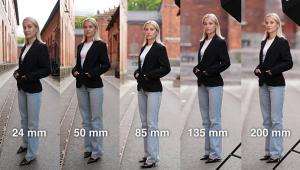Help!
Here Is A Quick Tip List On Letters For The HELP! Desk:
Please confine yourself to only one question per letter. Both postal letters and e-mails are fine, although we prefer e-mail as the most efficient form of communication. Send your e-mail queries to editorial@shutterbug.com with Help in the subject header and your return e-mail address at the end of your message. Although we make every effort, we cannot promise to answer every HELP! letter.
When sending a response or suggestion that refers to a published letter please include the month and page of the original question.
All postal letters to HELP! must be accompanied by a stamped, self-addressed envelope to be considered for reply. We will respond to e-mail queries with an e-mail.
Starblitz Settings
Re: a query about Starblitz 3300 DTS settings. The answer is that the “O, N, M, C/P, S” stands for camera brands: O=Olympus, N=Nikon, M=Minolta, C/P=Canon/Pentax, S=Standard. Also, on the front is a switch with White, Green, and Red options. While I don’t recall the purpose of the White, the Red and Green relate to the slide switch on the back which illustrates the flash range, depending on which f/stop the lens is set on, and the film speed. The Starblitz 3300 DTS is, by the way, the best flash ever produced. I bought mine in the early 1980s for a lot of money then (around $125), choosing it over the popular Vivitar 3500. It still lights up mounted to my reliable Canon AE-1. I have the unmatched ability to use the bounce/swivel flash to the max, and always use the soft fill flash to fill in the common under the nose and chin shadows. The fill flash also works great outside when I want natural light but need just a touch of flash when the subject is under a tree, or in some other shadow, etc.
Ken Summers
via e-mail
Thanks for providing assistance for our reader Alan Harbour who owns a Starblitz flash and was unsure how to set/use it.
DiMAGE 7 Power Points
Q. I have a Minolta DiMAGE 7 digital camera which no longer functions powered by four AA batteries (the requisite part is no longer available) but still works with a cord from the wall socket. Is there any portable battery that can supply the equivalent of household current to power this camera?
Hugh Boroson
Gloversville, NY
A. To properly answer your question I contacted Jon Sienkiewicz who was with Minolta for nearly 30 years and is very familiar with most of their photographic products. Here are his comments: “Theoretically such an accessory could be built. The DiMAGE 7 requires 6v DC (4 x 1.5v AA) to operate, so you could cut the cord from a DiMAGE 7 AC adapter and connect it to a third-party battery holder. You’d have an ungainly tangle to deal with, but it could be done. The DiMAGE 7, which was officially announced to the world on May 23, 2001, has many virtues, including a missing IR cutoff filter, so it’s popular among the digital infrared crowd. But truth be told, she’s an energy pig and notorious when it comes to depleting batteries. Given the alternatives I can conjure, I’d either look for a clean, used DiMAGE 7 or—if IR wasn’t the compelling motivation—upgrade to a more modern camera.”
Pentax Repair
Q. I am unable to find a repair center for a Pentax SF-1 35mm film camera. Pentax no longer services this camera. I have owned it since September 1987. Is there any repair facility for this equipment?
Frank Ortiz
via e-mail
A. We carry a service and repair listing in each issue of reputable firms that specialize in repairs and they often indicate the brands they work on. One that included Pentax in their recent ad is Photo Tech Repair Service, Inc. (110 East 13th St., New York, NY 10003; (212) 673-8400; www.phototech.com). Another firm our readers have favorably commented on is Camera Repair Japan (3435 Breckinridge Blvd., Ste. #130, Duluth, GA 30096; (888) 226-6678; www.camerarepairjapan.net). Before sending any equipment off for repair, be sure to contact each firm to explain your particular problem and try to obtain an estimate before packing and shipping your equipment to them.
Flash Voltage
Q. I had the option to buy a Quantaray QDC-900WA Digital Zoom flash during Ritz Camera’s going-out-of-business sale. On the box it had “Canon 10, 20, 30D” so I bought it for my 50D. I read an article about using off-brand flashes since they may use high voltages and damage camera circuit boards. I called Canon and they recommended against it, and Ritz has no customer service to speak of. What is your opinion? I haven’t used it to date.
Mel
via e-mail
A. It’s my understanding that high voltage is typically found only in older flash units made for film cameras. There are hot shoe adapters available which will regulate the flash voltage down to an acceptable level so older models of flash units can be safely used. However, since you have a newer model flash designed for use with digital cameras, this should not be a problem. If in doubt, then use the voltage regulator/adapter.

































